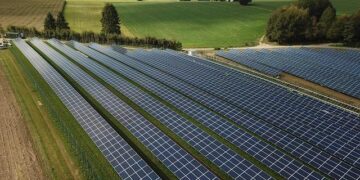ByRobin George Andrews
Published July 24, 2023
• 5 min read
For centuries, the country’s western volcanic peninsula has been dormant, but a new era of volcanic activity could be on the horizon.
The Fagradalsfjall Volcano, a raised crater of bubbling lava—glowing bright yellow in an expanse of dark gray—is the latest eruption heralding Iceland’s new period of volcanic activity.
(You can watch a live stream of the volcano here.)
The eruption announced its approach on July 4 of this year, when southwest Iceland was rocked by more than 2,000 earthquakes in just 24 hours. Not long after, seismic activity dropped off as magma rose to shallow depths and ultimately gave way to oozing molten rock on July 10.
Located next to the small mountain of Litli-Hrútur, this eruption is taking place on Reykjanes, a volcanically active peninsula that has become a popular destination among tourists looking to see lava fountaining above and pouring onto the surface. However, the site of the new eruption is potentially hazardous—new fissures may open nearby without warning, rivers of lava can form at a quick pace, and toxic gas can quickly fill the air, according to the Iceland Met Office.
This eruption is the peninsula’s third volcanic paroxysm in a row, following on from similar lava-spewing eruptions in 2021 and 2022—and it’s unlikely to be the last.
After an eruption last summer, Dave McGarvie, a volcanologist at Lancaster University, told National Geographic that the recent uptick in volcanic activity, “… could herald the start of decades of occasional eruptions.”
Iceland’s volcanic geology
The Reykjanes Peninsula lies about 17 miles southwest of Iceland’s capital city Reykjavik. It sits atop the continually spreading Mid-Atlantic Ridge, where the North American plate to the west and the Eurasian plate to the east are gradually pulling apart. Superhot, gassy magma, which is less dense than the surrounding rock, can sometimes rise into the shallow crust from buoyancy alone, but all that regional stretching also creates cracks where molten rock can infiltrate.
The peninsula’s subterranean bedlam seems to manifest as periodic busts of volcanism. Historical accounts and studies of ancient volcanic rocks show that times of volcanic repose transition into loud seismic and eruptive awakenings in a cycle that’s transpired several times in the past few millennia.
Although the region had been volcanically dormant for centuries, the tectonic sundering happening in the depths meant that the latest eruptions have long been in the works.
A fiery new beginning
And in recent years, several sheets of magma ascended toward the surface, indicated by the changing shape of the ground and swarms of earthquakes, says Tobias Dürig, a volcanologist at the University of Iceland. But for some time, these magmatic serpents failed to see sunlight—their escape was stymied either from the loss of their own upward momentum or because the resilient crust didn’t offer an escape hatch.
Nevertheless, as earthquakes began to crescendo in both frequency and strength from late 2019 onwards, scientists suspected that an eruption sometime in the future seemed inevitable. That was confirmed in dramatic fashion on March 19, 2021, when lava began gushing from a 1,650-foot-long fissure in a valley of the Geldingadalur region.
These ferocious fires are gifting scientists with an unparalleled look at the connective tissue between the igneous abyss below and the lava-licked landscape above. Their efforts help improve our understanding of Earth’s viscera, of Iceland’s volcanic cadence, and of this peninsula’s volcanic dangers.
This article was adapted from an article published in 2022. Read more about Iceland’s volcanoes here.
>>> Read full article>>>
Copyright for syndicated content belongs to the linked Source : National Geographic – https://www.nationalgeographic.com/environment/article/iceland-eruption-fiery-volcano-earthquakes






























